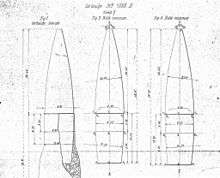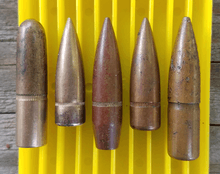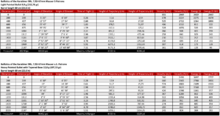Spitzer (bullet)
The spitzer bullet, also commonly referred to as a spire point (this reference is incorrect as Spire Point is a proprietary term describing a spitzer style bullet), is primarily a small arms ballistics development of the late 19th and early 20th century, driven by military desire for aerodynamic bullet designs that will give a higher degree of accuracy and kinetic efficiency, especially at extended ranges. To achieve this, the projectile must minimize drag in flight.

Bullets with a lower drag coefficient (Cd) decelerate less rapidly. A low drag coefficient flattens the projectile's trajectory somewhat at long ranges and also markedly decreases the lateral drift caused by crosswinds. The higher impact velocity of bullets with high ballistic coefficients means they retain more kinetic energy.
The name "spitzer" is an anglicized form of the German word Spitzgeschoss, literally meaning "pointed projectile".
The development of spitzer bullets made military doctrines possible which expected (not very accurate) rifle volleys at area targets at ranges up to 1,420 to 2,380 m (1,550 to 2,600 yd). Combined with machine guns equipped with clinometers that could deliver plunging fire or indirect fire at more than 3,000 m (3,280 yd), spitzer bullets greatly increased the lethality of the battlefield during World War I. Before, during and after World War I some militaries adopted aerodynamically more refined spitzer boat tail bullet designs with improved maximum ranges of 4,115 to 5,500 m (4,500 to 6,010 yd), though plunging fire or indirect fire methods were not as commonly used by machine gunners during World War II as they were during World War I.
Most spitzer bullets are loaded in intermediate and high-powered rifle cartridges.
History
Late 19th century

France
The spitzer bullet design was first introduced in 1898 as the Balle D by the French Army. The Balle D bullet was designed by Captain Georges Raymond Desaleux, in order to improve the ballistic performance of the existing French 8×50mmR Lebel service cartridge of 1886.
The original 1886 pattern 8×50mmR Lebel cartridge was an innovative service cartridge design, since it was the first military cartridge to use single-base smokeless, nitrocellulose based, (Poudre B) gunpowder as developed by Paul Vieille in 1884. The original 1886 pattern 8×50mmR Lebel was loaded with a 15.0 grams (231 gr) cupro-nickel-jacketed lead-cored flat-nosed wadcutter-style Balle M bullet designed by lieutenant colonel Nicolas Lebel achieving a muzzle velocity of 628 m/s (2,060 ft/s).
The new 1898 pattern 8×50mmR Lebel cartridge loaded with Desaleux's new lighter 12.8 grams (198 gr) Balle D brass mono-metal spitzer bullet achieved a muzzle velocity of 700 m/s (2,300 ft/s), providing a somewhat flatter trajectory and a greatly improved maximum effective range. Besides having a pointed nose section the Balle D was also the first military rifle projectile that had a boat tail - a streamlined tapered base - to further minimize air resistance in flight.[1]
Downrange performance
The 1898 pattern 8×50mmR Lebel Balle D spitzer nose profile combined with the boat tail resulted in a ballistic coefficient (G1 BC) of 0.568 to 0.581 (ballistic coefficients are somewhat debatable). Fired at 700 m/s (2,300 ft/s) muzzle velocity the Balle D bullet retained supersonic velocity up to and past 800 m (870 yd) (V800 ≈ Mach 1.13) under ICAO Standard Atmosphere conditions at sea level (air density ρ = 1.225 kg/m3) and had a maximum range of approximately 4,400 m (4,812 yd). Even by 21st century standards 800 m (870 yd) typical effective supersonic range is regarded as normal for a standard military rifle round.[2]
| Distance (m) | 0 | 200 | 400 | 600 | 800 | 1000 | 1500 | 2000 |
|---|---|---|---|---|---|---|---|---|
| Trajectory (m) | 0 | 0.14 | 0.81 | 2.39 | 5.27 | 9.83 | 31.71 | 75.61 |
| Velocity (m/s) | 628 | 488 | 397 | 335 | 290 | 255 | 197 | 160 |
| Distance (m) | 0 | 200 | 400 | 600 | 800 | 1000 | 1500 | 2000 |
|---|---|---|---|---|---|---|---|---|
| Trajectory (m) | 0 | 0.12 | 0.54 | 1.43 | 3.01 | 5.60 | 18.30 | 44.0 |
| Velocity (m/s) | 700 | 607 | 521 | 448 | 388 | 342 | 278 | 240 |
The above downrange performance tables show the superior velocity retention of the Balle D compared with its Balle M predecessor
Note: The air density ρ used to correlate these tables is unknown.
1900–1914
German Empire
In Germany the Gewehr-Prüfungskommission (G.P.K.) (Rifle Testing Commission) was responsible for improving the accuracy and performance of the 1888 pattern military M/88 ammunition and Germany's weapons chambered for M/88 ammunition like the Gewehr 1888. During a late 19th and early 20th century improvement program tasked with remedying the M/88's propellant compression and excessive barrel (grooves) wear problems, the German ordnance authority began to prefer spitzer bullets by 1898.
A new Spitzgeschoß aerodynamic bullet, credited to the independent ballistician Arthur Gleinich, was tested in 1902 and officially adopted on 3 April 1903. After several shape revisions it entered mass production in 1904. The Spitzgeschoß nose was externally pointed like the French design and its shape was patented, but the full metal jacket Spitzgeschoß differed internally.[5][6][7] The Gewehr-Prüfungskommission program resulted in the S Patrone or 7.92×57mm Mauser cartridge, which was loaded with a relatively lightweight 9.9 grams (153 gr) spitzer bullet with a slightly increased diameter of 8.2 mm (0.323 in) that had a ballistic coefficient (G1 BC) of approximately 0.321 to 0.337 (ballistic coefficients are somewhat debatable), along with a dimensionally redesigned chambering and bore (designated as "S-bore") and new double-base (based on nitrocellulose and nitroglycerin) smokeless powder loading, which delivered a greatly improved muzzle velocity of 878 m/s (2,880 ft/s) from a 740 millimetres (29.1 in) barrel. The S Patrone was adopted by the German Army and Navy in 1903 and had a maximum range of approximately 3,700 m (4,050 yd).[8][9] The combination of increased muzzle velocity and improved bullet aerodynamics provided a much flatter bullet trajectory, which increased the probability of hitting an individual target at most typical combat distances.
At the onset of World War I, Germany developed an aerodynamically further refined bullet. This 12.8 grams (198 gr) full metal jacket s.S. (schweres Spitzgeschoß, "heavy spitzer") boat tail projectile had a ballistic coefficient (G1 BC) of 0.557 to 0.593 (ballistic coefficients are somewhat debatable) and was loaded in the s.S. Patrone. At 760 m/s (2,493 ft/s) muzzle velocity the s.S. Patrone had a maximum range of approximately 4,700 m (5,140 yd) and retained supersonic velocity up to and past 1,000 m (1,100 yd) (V1000 ≈ Mach 1.07) under ICAO Standard Atmosphere conditions at sea level (air density ρ = 1.225 kg/m3). From its 1914 introduction the s.S. Patrone was mainly issued for aerial combat and as of 1918 in the later stages of World War I to infantry machine gunners. Fifteen years after World War I the S Patrone was phased out and the s.S. Patrone became the standard issue ball ammunition for the German military.[10][11]
United States

In 1906, United States ordnance authorities arranged to purchase the production license for the Spitzgeschoß bullet design from Gleinich. Now referred to as a 'spitzer' design, the new 9.7 grams (150 gr) flat base projectile that had a ballistic coefficient (G1 BC) of approximately 0.405 with a cupro-nickel alloy jacket was incorporated into the M1906 .30-06 Springfield cartridge adopted by U.S. armed forces in 1906. The Ball, M1906 rounds had a muzzle velocity of 823 m/s (2,700 ft/s) and had a maximum range of approximately 3,117 m (3,409 yd) and can be identified by their silver-colored bullets. The cupro-nickel alloy was found to quickly foul the bore.
Russian Empire
In 1908 the Russian Empire adopted a new 7.62×54mmR service round variant loaded with the "L" 9.61-gram (148.3 gr) Лёгкая Пуля (Lyogkhaya pulya, "Light Bullet") spitzer bullet that had a ballistic coefficient (G1 BC) of approximately 0.338. The 7.62×54mmR M1908 Type L cartridge had a muzzle velocity of 865 m/s (2,838 ft/s).
United Kingdom of Great Britain and Ireland
In 1910 the United Kingdom of Great Britain and Ireland officially adopted the .303 British Mark VII cartridge variant loaded with an 11.3 grams (174 gr) flat base spitzer bullet that had a ballistic coefficient (G1 BC) of approximately 0.467. The .303 British Mark VII cartridge had a muzzle velocity of 744 m/s (2,441 ft/s) and a maximum range of approximately 2,743 m (3,000 yd).[12][13]
Switzerland
In 1911 Switzerland adopted the 7.5×55mm GP 11 cartridge loaded with a 11.3 grams (174 gr) spitzer full metal jacket bullet. Besides a pointed nose, the GP11 bullet also had a boat tail. The GP11 projectile had a ballistic coefficient (G1 BC) of 0.505 to 0.514 (ballistic coefficients are somewhat debatable) and had a maximum range of approximately 5,500 m (6,015 yd). At 780 m/s (2,559 ft/s) muzzle velocity the standard GP 11 ball spitzer bullet retained supersonic velocity up to 800 m (870 yd) (V800 ≈ Mach 1.1) under ICAO Standard Atmosphere conditions at sea level (air density ρ = 1.225 kg/m3). The GP 11 bullet set off the militaries of countries like Germany, the United States and the United Kingdom at the onset of and after World War I to develop and field similar full metal jacket boat tail spitzer bullets to improve the maximum range and long range performance of the full metal jacket flat based spitzer bullet designs they used.
Kingdom of Spain
In 1913 the ordnance authorities of the Kingdom of Spain issued a redesigned 7×57mm Mauser cartridge (7mm Cartucho para Mauser Tipo S).[14] It was loaded with a 9 grams (138.9 gr) spitzer bullet fired at a muzzle velocity of 850 m/s (2,789 ft/s) with 3,251 J (2,398 ft⋅lbf) muzzle energy from a 589 mm (23.2 in) long barrel. It had a maximum range of 3,700 m (4,050 yd).[15]
Post 1918
Sweden
In 1932 Sweden introduced the 8×63mm patron m/32 loaded with 14.2 g (219 gr) spitzer bullets with a boat tail fired at a muzzle velocity of 760 m/s (2,493 ft/s) bullets. The 8×63mm patron m/32 ammunition was not developed as general service ammunition but for anti-aircraft and indirect fire and had an effective range of approximately 3,600 m (3,937 yd) on which the impact energy was 196 J (145 ft⋅lbf), and a maximum range of approximately 5,500 m (6,015 yd) when fired from a kulspruta m/36 machine gun.[16]
Sweden and Norway loaded their 6.5×55mm m/94 service ammunition with a 10.1 grams (156 gr) long round-nosed bullet (B-projectile) fired at a muzzle velocity of 725 m/s (2,379 ft/s) up to the early phase of World War II and Norwegian occupation by German in 1940. From 1941 onwards Sweden, which remained neutral during World War II, adopted m/41 service ammunition loaded with a 9.1 grams (140 gr) spitzer bullet (D-projectile) fired at a muzzle velocity of 800 m/s (2,625 ft/s).[17] Besides a pointed nose the m/41 D-projectile also had a boat tail.[18]
References
- Chuck Hawks. "The 8x50R Lebel (8mm Lebel)".
- Maximum effective rifle range
- The 8mm (7,92X57) Mauser Cartridge, Ballistics of the F.N. Rifle, Cal. 7,9 m/m Streamlined Pointed Bullet with Tapered Base (197.5 gr.)
- FN Mauser Model 98 rifle and carbine operator's manual
- Hans-Dieter Götz (1974). Die Deutschen Militargewehre und Maschinenpistolen: 1871-1945 (in German). p. 133. ISBN 3-87943-350-X.
- The patent assigned by the US Patent Office to the Deutsche Waffen- und Munitionsfabriken Aktien-Gesellschaft for an Improved Form for Projectiles for Hand-Firearms can be found under US PAT No. RE12927.
- Patent US 841861 A Projectile for hand-firearms (1907).
- The 8mm (7,92×57) Mauser Cartridge, Ballistics of the F.N. Rifle, Cal. 7,9mm Light Pointed Bullet (154 gr.) S Patrone
- 8×57mm IS cartridge portrait - Totgesagte leben länger, Wild und Hund 11/2006 (in German) Archived 2011-10-01 at the Wayback Machine
- Die Patrone 7.92mm (8x57)
- 20th Century German Military Arms and Ammo
- "Rifle, Short Magazine Lee Enfield". The Lee-Enfield Rifle Website. Retrieved 13 May 2010.
- David Cushman. "History of the .303 British Calibre Service Ammunition Round".
- The Spanish Modelo 1893 Mauser Rifle by Paul Scarlata • Shooting Times • September 23, 2010
- FN Mauser Model 98 Rifle and Carbine Operator's Manual page 28 Archived 2012-05-10 at the Wayback Machine
- Swedish Kulspruta m/36 at forgottenweapons.com
- Swedish Military Rifles 1894 - 1995
- 6.5x55 Ammunition
External links

